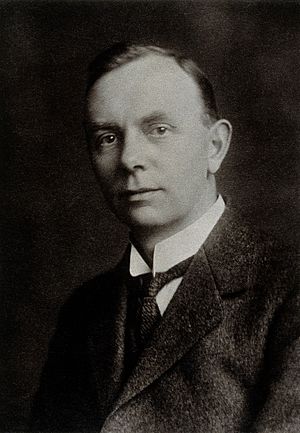Patrick Laidlaw facts for kids
Sir Patrick Playfair Laidlaw FRS FRCP (1881–1940) was an important Scottish scientist. He was a virologist, which means he studied viruses and the diseases they cause.
Contents
Early Life and Education
Patrick Laidlaw was born in Glasgow, Scotland, on September 26, 1881. His father, Robert Laidlaw, was a doctor. Patrick went to Leys School in Cambridge. Later, he studied at St. John’s College, Cambridge University.
Discoveries in Virology
Sir Patrick Laidlaw made big contributions to medical science. He worked as a virologist for the Medical Research Council.
Fighting Dog Distemper
In 1922, Laidlaw began studying dog distemper. This is a serious disease that affects dogs. His research led to two ways to protect dogs from distemper. These methods helped create vaccines. Because of this important work, he received a special award. It was called the Royal Medal from the Royal Society in 1933. He had also become a fellow of the Royal Society in 1927. This means he was recognized as a leading scientist.
Finding the Flu Virus
Sir Patrick Laidlaw was also part of a team that made another huge discovery. They were the first to find the influenza virus in humans. This happened at the NIMR Farm Laboratories in Mill Hill. The scientists were working with ferrets to develop a distemper vaccine. One day, some ferrets caught the flu from a scientist. This helped the team identify the human flu virus.
Later Life and Legacy
For his great service to medical science, Patrick Laidlaw was knighted in 1935. This means he was given the title "Sir." He passed away on March 20, 1940, at the age of 58. His work helped us understand and fight serious diseases like distemper and influenza.


